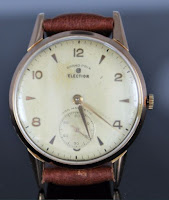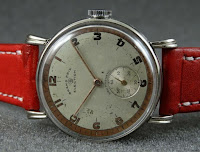Election was founded circa 1850 as A. (for Alphonse) Braunschweig in La Chaux de Fonds. In 1906, Alphonse’s son, Arnold, took over the company at age 22 after the father died in a freak accident while on a trip to Tyrol. A year later, the brand name Election was registered.
The company took a Grand Prize at the Berne Exhibition in 1914, and that is why the words “Grand Prix” appear on many of their watch dials and in many ads for Election.
Also, the numeral 1914 is engraved on the backs of many Election watches. More than one seller and auction house has confused that number as a reference (model) number, and even a year of production!
In 1920, the company added “Election” to their name, and by 1932 dropped the Braunschweig name and became Nouvelle Fabrique Election, or Election for short. They made many of their own movements, some of which were sold as ebauches (rough movements) to other companies, including Longines. The "Grand Prix" became their most famous signature and is found on many of their dials, though as far as I can tell it's simply a reference to the 1914 award and not necessarily a model line. Election was listed in various directories 1950-1954.
 |
| 1955 |
In 1950, Marvin watch company acquired Election and many of the Election branded watches used Marvin movements after that, including the Marvin Cal. 700 and 700C (calendar) which, ironically, are both based on the Election Caliber 875. And Marvin eventually became part of the MSR Group, which at one time included Marvin, Phenix, and Vulcain, among other brands. The brand largely disappeared after the 1960s, but examples do pop up now and again, like the "Saucer" and the mechanical digital pictured:
Election was founded by Alphonse Braunschweig in La Chaux de Fonds in 1848. Alphonse’s sons, Arnold, Lucien, and Georges took over the company after Alphonse died in a freak accident while on a trip to Tyrol.
Election is another one of those brands that was fairly well known in the '50s and '60s post-war boom, but that faded into obscurity and is known today only by collectors of vintage timepieces.

The company took a Grand Prize at the Berne Exhibition in 1914, by which time Election was one of the largest watch manufacturers in La Chaux-de-Fonds. The prize award is why the words “Grand Prix” appear in many ads for Election, and the numeral 1914 is engraved on the backs of many Election watches. More than one seller and auction house has confused that number as a Reference (model) number, and even as a year of production. But is simply a reference to their 1914 award.
Tragedy would strike the Braunschweig family again when Arnold, born 1884, died in the 1918 Spanish flu pandemic. In 1920, the company added “Election” to their name and became "Les Fils de L. Braunschweig, Fabrique Election." Another early wristwatch (below left) bears a striking resemblance to a Gruen Quadron of the same name:

 |
| A rare '30s tonneau |

Election worked closely with Marvin in the post-war period, and the two companies shared some watch movements. For example, Election's Cal. 875 became Marvin's Cal. 700 in the 1960s. This movement was later also used by Longines as Cal. 490. Similarly, Marvin's rectangular Cal. 160 became Election's Cal. 275. The Election brand was well represented in Asia and Latin America, where it was often partnered with Girard-Perregaux.
At this point, we’ll look at some vintage advertisements from Election’s heyday in the 1940s and ‘50s.

One advertisement in 1960 (left) called attention to an Election Grand Prix watch that was carried by crew members of the raft Tahiti Nui. This expedition attempted to discover a plausible route from Tahiti to Chile's Easter Island, 2,360 miles off the coast of Chile, and long a source of mystery as to how the island became inhabited. The ad campaign was very probably designed to compete with Eterna's Kon Tiki.
Other model names Appearing in the 1950s included Tropical Special, Electrovar, Gold Hood (see ad above), Everlast, Timelight, Connoisseur, Evergreen, Ocean King, Everbest, Super-Electron, Carrier, Electrion, and Superdate de Luxe.
Lucien Braunschweig died in July of 1958 at the age of 73. He had guided Election and Nouvelle Election for over 50 years and was greatly involved in La Chaux-de-Fonds commercial activities as well.

In the 1960s, Election emphasized their high-jewel watches. The Supermatic 41 (left) had a 41-jewel movement with date and central seconds.

L to R: Two chronographs with Valjoux 22 movement; black dial, subsigned Cuervo y Sobrinos, a luxury jeweler based in pre-Castro Cuba; bullseye dial.





















No comments:
Post a Comment